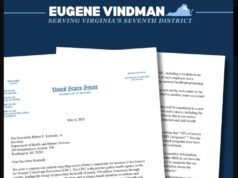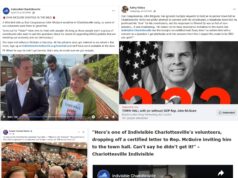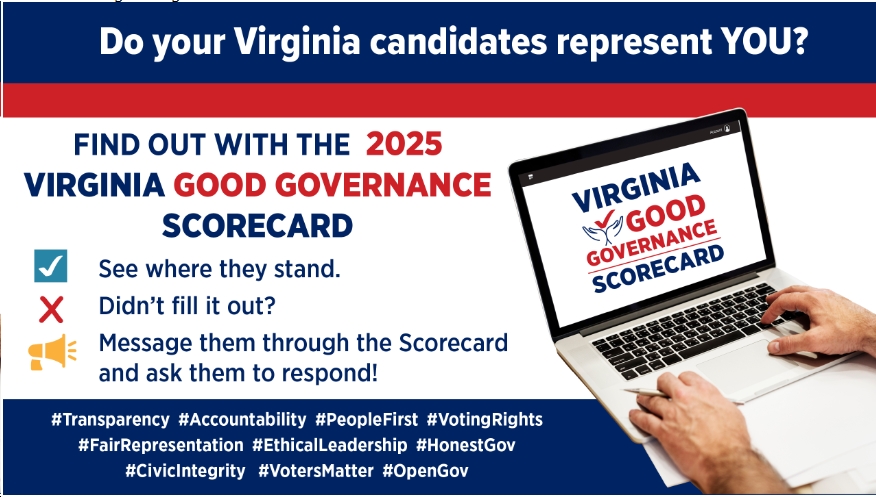 by Paul Goldman
by Paul Goldman
Here at 200-proof politics, we play the ball the same way as in golf with one exception: when you land in a hazard, there are no free drops, no penalty strokes. You play it like it lays, or is it lies, you would think by now I would know the difference! Meaning: We were the first to go on record predicting a Democratic sweep, perhaps one like in 1981 when Robb won decent, Davis crushed a GOP LG nominee who had self-imploded, and Baliles eked out a win over Durrette as Republican ticket-splitters came home. Moreover, we stick to our sweep prediction even though, on an historical basis, it would mark the FIRST TIME in the two-party era that a Republican didn’t hold at least one of the 5 statewide elected offices.
COULD WE BE WRONG? That’s a fair question but a better one in our view is this: Is there a mathematical case to be made against the sweep thesis, that is to say is there a mathematical model – within normal ranges – that poses a realistic statistically based challenge to the sweep thesis? Or better yet: Is there a mathematical model that shows how Cuccinelli can win despite all the odds against it right now?
OUR ANSWER: After studying the data, what follows would be a mathematical explanation of how a Cuccinelli victory would look in statistical terms. As with any statistical projection, the key question is this: What is the probability of it occurring? Our prediction of a Dem sweep – and thus a McAuliffe victory – doesn’t deny the existence of what follows, it merely rates the probability right now as so low as to be “ain’t happening baby.”
BUT IF WE ARE GOING TO BE WRONG, and the reason is not going to be an unpredictable event/scandal/revelation/whatever, then a Cuccinelli victory will have to revolve around the following statistical construct, give or take.
In 2009, the Virginia electorate went from 7 percentage points more Democrats than Republicans in the previous year’s presidential contest to 4 percentage points more Republicans than Democrats in the 2009 exit poll. 2008 was a perfect storm year for Democrats, 2009 a perfect storm year for Republicans. In 2012, Virginia’s enthusiasm for President Obama had waned according to all the polls: yet the electorate remained 7 percentage points more Democratic. The growing demographic advantages for Democrats appear to have been working to overcome the enthusiasm gap.
That’s a good Democratic sign for 2013. On the other hand, it is self-evident Republicans are not as united in VA this year, that Mr. Cuccinelli will not have the huge money advantage held by Mr. McDonnell four years ago, and I could go on: bottom line, this is not a perfect storm year for a GOP GUV candidate. That is, on the plus side!
First, a Two-Way Race
Let’s give Mr. Cuccinelli every single possible break and assume the electorate is + 4% more Republican than Democrat again this year, essentially meaning Terry and the Democrats will have wasted $10 million this year on turnout efforts when all is said and done. It is possible based on previous data points.
Moreover, to give Cuccinelli even more of a statistical head start, let’s assume the electoral is 37% Republican, 33% Democratic and only 30% independent, same as in 2013.
FURTHER: The polls show that Mr. Cuccinelli is on target to get less Democratic vote than any successful GOP candidate IN THE HISTORY OF VIRGINIA. But again, let’s give Ken all the mathematical breaks and assume that Terry only wins Democrats 95% to 5%, or a net 90 percentage-point margin. This means Cuccinelli would do nearly as well among Democrats as McDonnell who won in a record landslide. It is possible, but again, it is way off the chart, likely is way back in the rear view mirror.
THE FIRST CUT OF VOTING MATH: If you multiply .9 x .33, you get .297. Or put another way for analysis of voting: Democrats will give Terry a net 29.7 percentage-point margin over Cuccinelli when you add up all votes from self-identified Democrats. Or if you prefer, Democrats will give Terry votes equal to 31.35% of the electorate in 2013, Democrats will give Cuccinelli 1.65% of the electorate. I prefer using net margin since it requires keeping track of only one data point.
FURTHER: The polls indicate what is now self-evident: Cuccinelli will see some erosion from voters who tell pollsters they are Republicans. How much erosion? Right now the polls do not provide a definite answer. But given the trends over time, a credible mathematical model has to assume that Cuccinelli will only carry Republican self-identified voters by 90% to 10%, or an 80 percentage-point net margin. It could be worse of course.
THE SECOND CUT OF VOTING MATH: If you multiply .8 x .37, you get .296. Or put another way for analysis of voting: Republicans will give Ken a net margin of 29.6% over Terry. Again, if you prefer, this means GOP voters will give Cuccinelli 33.3% of all ballots cast, and Terry 3.7%.
SUMMARY TO DATE: On a net margin basis, Terry leads by 0.1 percentage points! Or put another way, the votes of self-identified Democrats and Republicans will give Terry McAuliffe 35.05% of the voting cast in November and these two groups will give Cuccinelli 34.95% of the ballots. The other 30% from independents or basically not of the two major parties.
MEANING: With the partisans essentially split, Cuccinelli could be elected Governor by carrying the independent vote 52% to 48%. Why? This would give him a net margin of .04 x .3, thus equaling 0.12%. This would give him a few more votes on election day than McAuliffe, in the closest recount ever for Governor. Right now, the polls indicate neither candidate can count on a majority of the independent vote, thus making the Post-Labor Day campaign seemingly crucial in that regard.
RECAPPING THEREFORE: Put another way, even with near record defections from Republican partisans, there is a mathematical case for Cuccinelli to win a two way race – within some loose normalized limits – although it requires a few leaps of faith in my view. BUT, bottom line: it isn’t mere fantasy.
THREE-WAY RACE
It is possible that the Libertarian candidate this year could get more than the expected vote. Studies suggest this extra vote will be roughly 50% of people who would not have voted for either of the major candidates and the other half those who would have voted for Cuccinelli or McAuliffe had there been no third choice. Logic further says this latter group will not be very large at all. But assume is 3% of the total two party electorate modeled above: that is to say, this 3% of the electorate voting Libertarian would have voted for either Terry or Ken had that been there only choice.
Is there any way to know for sure how they would have voted in a pure two way? NO. Democrats assume those 3% are net/net more Republican than Democrat, using Ron Paul as the example. But this may not be true given that the Libertarian candidate is likely to appeal more to younger voters who are more Democratic than older Virginia voters.
Meaning: it is possible that the Libertarian candidate, on a net, net basis, could reduce Terry’s net margin over Cuccinelli by as high as .6% in terms of what it would otherwise be in a two way race. Or put another way: If McAuliffe would have won a two way race 50.3% to 49.7%, the three-way race would now be a dead heat on election day.
I rate this variable very low but again, not pure fantasy.
CONCLUSION
On a math basis, the key statistical problem facing Cuccinelli is this data point: he figures to lose a statistically significant chunk of self-identified Republicans right now, costly him perhaps 3-4% net percentage of the total electorate. That is huge. However, if you assume a 2009 turnout model, even a campaign hobbled by all things facing Cuccinelli could survive if it could win the independent vote: and right now, the polls indicate this is true although I wonder if that is really the case.
But since a 2009 turnout model seems most unlikely, this means the following: Cuccinelli has to make the loss of GOP partisans, lower turnout amount Evangelical Christians on a normative basis, a better marginal turnout among Democrats who don’t usually vote in a GUV race and a loss of some Democrats who normally vote Republican in the GUV race.
Thus, his statistical problem: The only place to make up for these loses is to find a new pocket of Republican voters who don’t normally vote in a GUV race. There are hundreds of thousands, they voted for Romney, but would not vote in 2013 normally. Can he get them to the polls? Democrats are saying publicly they can bring presidential year only DEMS to the polls this year. The GOP isn’t saying whether they are likewise trying. It is costly.
Moreover: If turnout is down on a relative basis among normal GUV year GOP voters, why would it go up among those who generally don’t vote? What would bring them to the polls?
Thus my statistical conclusion: If Cuccinelli can’t motivate the folks who voted in 2009, he can’t get much of a new group to the polls right now.
Thus, he needs to have a strategy that will motivate his normal GUV year base voter to the fever pitch of 2009 while at the same time winning the independents.
Statistically it is doable: but he doesn’t have a strategy to do it right now. Rather, he has ceded some ground to McAuliffe who seems to have a strategy to take advantage thereof.
This is all compounded by Cuccinelli’s decision to waste $millions on a TV ad buying strategy that can not work despite the fact he is facing a better funded McAuliffe. Everyone in the business is perplexed by his ad buying approach: it makes no logical sense.
That’s it in a nutshell: The case against the Goldman sweep thesis.
Statistically speaking, Democrats need not worry about Cuccinelli until he figures out how to thread the needle. Is it possible? Yes. Ironically, the guy who did it best for Republicans was Boyd Marcus, who cooked up the strategy for Jim Gilmore in 1997. He is working for McAuliffe now.
Cuccinelli’s strategy is, in my view, nothing at all like the strategies of every successful GOP GUV candidate in the modern era except maybe Godwin’s in 1973, based on Sabato’s writings about that race and the book by Garrett Epps.
By September 15th, the final strategies are basically set on an historic basis.
That’s roughly 3 weeks away. In that period, the Goldman sweep thesis could be derailed. But if not, then it is going to take something outside the normative to upset the math in my view.

 Sign up for the Blue Virginia breaking news newsletter
Sign up for the Blue Virginia breaking news newsletter









